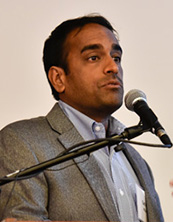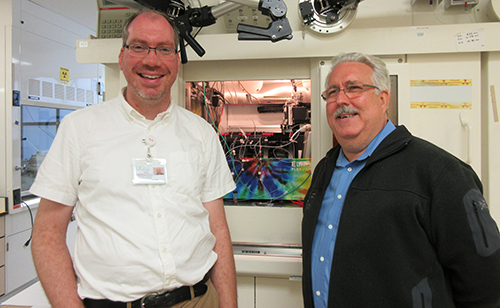.jpg) Dr. Warner Greene
Dr. Warner GreeneBoosting the Immune Response
The first published findings to be generated by researchers at the amfAR Institute for HIV Cure Research appeared in the prestigious journal Nature Medicine in June. Researchers at the San Francisco VA Medical Center (SFVAMC), led by research associate Dr. Peilin Li and including the amfAR Institute’s Dr. Warner Greene, report that a substance called retinoic acid can stimulate immune cells to eliminate HIV-infected cells. "The potential to exploit our innate immune response to both ‘shock and kill’ latent HIV reservoir cells is exciting,” Greene said. ‘Shock and kill’ refers to using a drug to induce persistently infected cells to produce HIV so that the immune system can detect and kill them. “Bringing these first-line immune defenses to bear could speed progress in our search for an HIV cure,” Li said.
 Dr. Satish Pillai
Dr. Satish PillaiForcing Persistent Virus to Reveal Itself
In a second amfAR Institute paper, published in June in PLOS Pathogens, scientists at Blood Systems Research Institute (BSRI) and UCSF reported that a compound called galectin-9 can force latent HIV-infected cells to reveal themselves to the immune system for eradication. Dr. Satish Pillai, associate investigator at BSRI and a lead researcher at the amfAR Institute, and his team found that by binding galectin-9 to the surface of HIV-infected cells, they can simultaneously restart virus production (i.e., reverse latency) and induce APOBEC3G, a naturally occurring antiviral protein that renders progeny virus uninfectious. “Our findings make us optimistic that future HIV treatments can eliminate all traces of the virus from the body,” Pillai said. “Ultimately, we hope galectin-9 gets us one step closer to a cure.”
Gene Therapy Think Tank

Ten gene therapy experts participate in an amfAR-sponsored think tank in Portland, OR.
Consistent with amfAR’s commitment to investigate every avenue that might lead to a cure, The Foundation regularly hosts think tanks that bring together leading investigators in various fields. Such a think tank took place in Portland, OR, June 24-26, when 10 gene therapy experts were invited to discuss this particular approach to curing HIV. While pharmacological and immunological approaches remain the dominant cure strategies, the only HIV cure documented to date involved a procedure that points to the promise of gene therapy. The researchers assessed progress to date, discussed the various gene therapy strategies currently being pursued, and developed recommendations for further advancing the field.
Cutting-Edge Imaging Technologies

Researchers Drs. Tim Henrich and Henry VanBrocklin pose at the amfAR Institute for HIV Cure Research at the University of California, San Francisco, in a facility that "tags" proteins for later imaging and study.
One of the four research modules within the amfAR Institute, headed by Dr. Satish Pillai of Blood Systems Research Institute, is charged with developing methods of accurately determining the size of the HIV reservoir. In some instances, this may mean being able to detect one persistently infected cell out of a billion—or even tens of billions—of cells. Among the tools being applied in this effort, Dr. Pillai and his team are using medical imaging techniques such as PET and CT scans to directly visualize the presence and distribution of persistently infected cells. These technologies have the advantage of being non-invasive and give researchers the ability to scan the whole body and take a snapshot of the relative burden of virus in tissues throughout the body. A June 6 symposium at UCSF, organized by the amfAR Institute, brought researchers together to review the latest imaging techniques and discuss their potential for assessing the effectiveness of experimental cure interventions.